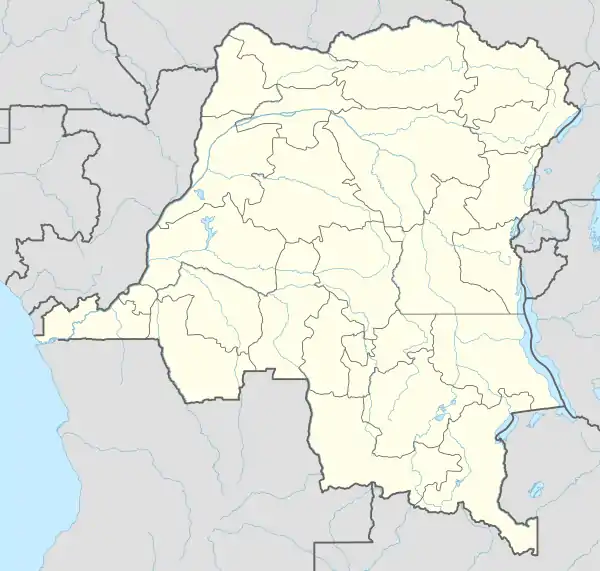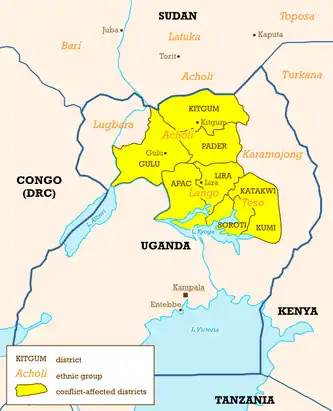2008 Christmas massacres
The Christmas massacres took place on 24–27 December 2008, when the Lord's Resistance Army (LRA), a Ugandan rebel group, attacked several villages in Haut-Uele District, Democratic Republic of the Congo.[1][2][3]
| Christmas massacres | |
|---|---|
 2008 Christmas massacres (Democratic Republic of the Congo) | |
| Location | Several villages in Haut-Uele District |
| Date | 24–27 December 2008 |
| Deaths | 620[1] |
| Perpetrator | Lord's Resistance Army[1] |
| Lord's Resistance Army insurgency |
|---|
 |
| Conflict history |
| Related articles |
Attacks
The LRA attacks followed the beginning of a joint military operation on 14 December, led by the Ugandan army with support from the Congolese, Southern Sudanese, and Central African Republic armies. The Ugandan army attacked the LRA headquarters in Congo's Garamba National Park, near the border with Sudan.
Following this attack, the LRA dispersed into several groups, each of which targeted civilians along its path. The rebels carried out the most devastating of their attacks from 24 December, waiting until people had come together for Christmas festivities, then surrounding and killing them by crushing their skulls with axes, machetes, and large wooden bats.[4]
Media reports indicated that more than 620 people were killed,[5] many of them hacked into pieces,[6] decapitated,[7] or burned alive in their homes.[7] Several people reportedly had their lips cut off as a "warning not to speak ill of the rebels",[8] and two three-year-old girls suffered serious neck injuries when rebels tried to twist their heads off.[4]
More than 20,000 people were reported to have been displaced by the attacks,[3][8][9] and at least 20 children were abducted by the LRA.[9][10] The United Nations High Commissioner for Refugees (UNHCR) reported that as many as 225 people, including 160 children, might have been abducted and more than 80 women raped.[3]
According to Human Rights Watch, "the similar tactics and the near-simultaneous attacks indicate this was a planned operation meant to slaughter and terrorize as many civilians as possible".[4] The LRA has denied responsibility for the attacks; an LRA spokesman suggested that LRA defectors who had joined the Ugandan army may have been responsible.[8]
Death toll
On 29 December 2008, the United Nations Office for the Coordination of Humanitarian Affairs estimated that 189 people had been killed on 26–27 December.[11] Caritas International has put the death toll at over 400,[12] while Human Rights Watch reported that at least 620 civilians were killed between 24 December and 13 January.[4]
At least five villages were attacked:
- Faradje: Approximately 150 people were killed on 25–26 December. Rebels reportedly attacked a Christmas Day concert organised by the Catholic Church, and returned the following morning to "continue their killing spree".[12] The UNHCR reported that at least 70 were killed and 37,000 people were forced to flee.[3] Human Rights Watch reported that at least 143 people were killed and 160 children and 20 adults abducted.[4]
- Batande: At least 80 people were killed on 25 December when rebels attacked a Christmas lunch following the morning church service.[4] The men and boys were reportedly taken about 40 meters from the church and killed immediately, then the women and girls were taken into the forest in small groups and many of them raped before they were killed.[4] One witness reported that only six people were left alive in the village.[4] The rebels then ate the Christmas feast the villagers had prepared and slept among the dead bodies.[4]
- Duru: 75 were reportedly killed and a church burned down in the village.[12][13]
- Bangadi: 48 were killed.[12]
- Gurba: 213 were killed.[12]
Reactions
On 30 December 2008, UN Secretary-General Ban Ki-moon condemned "the appalling atrocities reportedly committed by the Lord's Resistance Army (LRA) in recent days".[7] The United Nations Mission in the Democratic Republic of Congo also condemned the attack and airlifted Congolose soldiers to Faradje to prevent further attacks.[11] The United Nations High Commission for Refugees said the situation was "catastrophic".[14] The European Commission condemned the attacks and called on the LRA "to immediately cease all criminal acts against the innocent people".[1] Caritas International said it was "shocked" by its staff reports of the massacres.[12]
References
- Agence France-Presse (3 January 2009). "Massacre by Ugandan rebels in DR Congo threatens region: EU". Retrieved on 4 January 2009.
- Kennedy, Elizabeth A. (31 December 2008). "Aid group: 400 dead in eastern Congo massacres". The Associated Press,retrieved on 4 January 2009.
- United Nations High Commissioner for Refugees (6 January 2009). "UNHCR visits Congolese towns attacked by Lord's Resistance Army".Retrieved on 7 January 2009.
- Human Rights Watch (17 January 2009). DR Congo: LRA Slaughters 620 in ‘Christmas Massacres’. Retrieved on 22 January 2009.
- "DR Congo: LRA Slaughters 620 in 'Christmas Massacres'". Human Rights Watch. 17 January 2009. Retrieved 11 April 2018.
- BBC News (29 December 2008). "Ugandan LRA 'in church massacre'". Retrieved on 4 January 2009.
- Agence France-Presse (30 December 2008). "Ugandan rebels kill 400 in DR Congo: charity". Retrieved on 4 January 2009.
- BBC News (30 December 2008). "Christmas massacres 'killed 400'". Retrieved on 4 January 2009.
- CNN (30 December 2008). "Congo groups: 400 massacred on Christmas day". Retrieved on 4 January 2009.
- Rice, Xan (29 December 2008). "Nearly 200 killed as rebel militia raids villages in Congo". guardian.co.uk. Retrieved on 9 January 2009.
- Mukasa, Henry (30 December 2008 Uganda: Kony Rebels Kill 400 Congo Villagers". allAfrica.com. Retrieved on 7 January 2009.
- Caritas Internationalis (29 December 2008). "Caritas reports Christmas Day massacre in Congo by Ugandan rebels Archived 16 January 2009 at the Wayback Machine". Retrieved on 4 January 2009.
- Agence France-Presse (28 December 2008). "Rebels kill 45 people in Congo church: Ugandan army". Retrieved on 4 January 2009.
- Zoe Alsop (3 January 2009). Uganda rebels kill 500 in DR Congo. The Daily Telegraph. Retrieved on 22 January 2009.